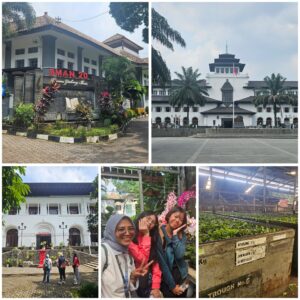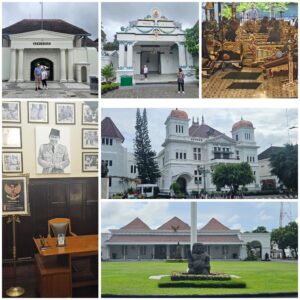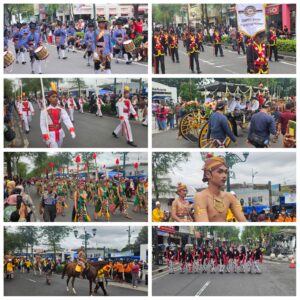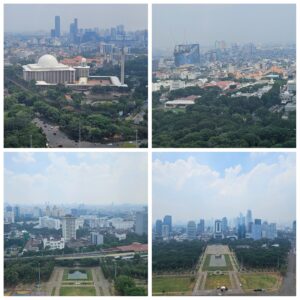Our journey across Java began in Jakarta, the former colonial capital of Batavia, whose history I have covered separately. From there we travelled to Bandung, Cimahi, Yogyakarta and Surabaya, exploring how Dutch colonial rule manifested in their architecture, urban form, and local governance. Across these cities we visited many of the same types of colonial buildings all in the so-called Indies architecture – the Gouverneurs Paleis, Gouverneurs Kantoor, Catholic and Protestant churches, the De Javasche Bank, the NEI Insurance Company, the Sociëteit Concordia, and the Post (Pos)Kantoor. Each city also had its European quarter, lined with beautiful trees, villas once occupied by colonial officials. Many remain intact, now mainly adapted for commercial use, except in Cimahi where, as far as we could see, houses are still occupied by officers of the Indonesian army – fitting, since Cimahi was and remains a garrison town. Remarkably, most of the colonial government and business buildings in all of the cities still serve their original administrative, banking or civic purposes today, showing how colonial infrastructure and institutions were absorbed rather than replaced.
Another lasting legacy of Dutch rule is the railway network, along with the public and private buildings that accompanied it. The stations built during the colonial period remain in active use, their solid construction and functional design forming a visible link with the past. More broadly, the Dutch laid down much of Indonesia’s civic infrastructure—railways, roads, bridges, irrigation systems, schools, hospitals, and administrative buildings—that still underpin the nation’s daily life. Obviously since that time significantly extended by Indonesia. Many Indonesians we spoke to noted that, while the colonial era brought hardship and inequality, it also left behind enduring structures of organisation and public service. These contributions, though born of colonial motives, continue to shape the practical and architectural foundations of modern Indonesia.
At the height of colonial rule in the early 1930s, the population of the Dutch East Indies was about 60.7 million. Of these, roughly 240,000 were classified as Europeans (including Indo-Europeans), about 1.2 million were ethnic Chinese, and the vast majority—over 97%—were indigenous Indonesians. The indigenous population was overwhelmingly poor, with most people living in rural villages and working in subsistence farming or on plantations under exploitative labour systems. Education, healthcare, and economic opportunity were largely restricted to the European and Chinese minorities. In less than a century, that population has grown nearly five-fold to around 285 million, and while inequality remains, Indonesia has transformed into a far more urbanised, diversified, and prosperous nation.
Bandung and Cimahi – administrative order and military discipline

Bandung developed as one of the Dutch East Indies’ most planned colonial cities. Its relative cool climate and fertile plateau (700 meters above sea level) made it an attractive administrative centre. The most recognisable building, Gedung Sate, completed in 1920 for the Department of Public Works, symbolises the Dutch ambition to combine European modernity with Javanese motifs. Its distinctive central spire, shaped like a satay skewer, gave the building its name.
The Technische Hoogeschool te Bandung (THB) was established on 3 July 1920 by the Dutch colonial government as part of the Ethical Policy (Ethische Politiek), which sought to provide limited educational and welfare improvements for the indigenous population. Located on a 30-hectare site in Bandung, it was the first and only university-level technical institution in the Dutch East Indies, initially offering a single faculty (Faculteit van Technische Wetenschap) and a major in Road and Water Resources Engineering. While access for Indonesians remained restricted and highly selective, the institution marked the beginning of higher technical education in the colony. After independence, the school became the Institut Teknologi Bandung (ITB), now one of Indonesia’s foremost universities in science and engineering, continuing the legacy of academic excellence begun under colonial administration.
Dutch tea factory in the Lembang hills

In the mountains just north of Bandung, near Lembang, we visited the Walini Tea Factory, established by a Dutch company between 1934 and 1937. It remains one of the few fully operational tea-processing facilities from the colonial era, still using the original Dutch-built machinery. The factory was part of a network of plantations developed under the Dutch Agrarian Law of 1870, which opened large tracts of highland forest to European agricultural enterprises. The area’s cool climate proved ideal for tea cultivation, introduced earlier from Ceylon and India. Workers continue to process the leaves in the same way as nearly a century ago, giving visitors a rare view of a living remnant of Java’s plantation economy.
The garrison town of Cimahi

Cimahi, nearby, was laid out as a military settlement in the late 19th century for the Koninklijk Nederlandsch-Indisch Leger (KNIL). It followed a strict grid plan, with barracks, parade grounds and officers’ quarters reflecting the precision of military design. Today, Cimahi still houses army facilities; its colonial layout and function largely unchanged.
Yogyakarta – royal continuity under colonial oversight

Yogyakarta offered a distinct atmosphere. We found it the most attractive city we visited. It is the seat of the Sultanate of Yogyakarta, the only surviving monarchy in Indonesia that still holds official political authority. By national law the reigning Sultan, currently Hamengkubuwono X, also serves as the hereditary governor of the Special Region of Yogyakarta. This arrangement continues a long history of dual rule: during the Dutch period the Sultan governed local affairs while the colonial Resident oversaw external and military matters.
We visited the Kraton Ngayogyakarta Hadiningrat, the Sultan’s palace complex which remains a living centre of Javanese culture. Its open courtyards, pavilions and banquet hall demonstrate how the palace blended traditional architecture with occasional European elements introduced through contact with the Dutch. Many of the Sutan’s sons were, during the colonial period, educated in the Netherlands.
Some earlier royal litters on display, carried by ten men on each side, remained in use until the late 19th century, when horses gradually replaced human bearers. The Kraton employs around 300 people, many serving as palace guards, musicians or caretakers. Half are volunteers the others receive a symbolic allowance – reported to be around 10,000 rupiah a month (A$10) – as their work is viewed as a spiritual duty rather than regular employment. Within the palace we listened to the resident gamelan orchestra – the largest we have ever seen – and attended a wayang kulit (shadow-puppet) performance, both integral to the Kraton’s ceremonial and artistic life. These arts, long supported by the court, express the moral and cosmic order central to Javanese belief.
During our stay we were based at the Phoenix Hotel, one of Yogyakarta’s finest colonial landmarks. Originally built around 1918 as a private villa for a Chinese businessman, the building was later converted into a hotel and retains much of its early 20th-century character. Its interior includes decorative artefacts from the former Sultan’s Palace of Solo, linking it to the royal culture of central Java. In 1946–47, during the brief period when Yogyakarta served as the capital of the newly declared Republic, the hotel housed the office of President Soekarno — a unique blend of colonial heritage and national history under one roof. The office is still maintained and we were gives special access to have a look inside, a secret door and an escape hatch were still kept in place
Kirab Trunajaya procession on Malioboro Street

By chance our visit coincided with the Kirab Trunajaya procession along Jalan Malioboro on 22 October 2025, an annual parade held for the Sultan’s Javanese-calendar birthday (Tingalan Dalem Taun). The procession moved up Yogyakarta’s main Malioboro street and finished at the Kraton, led by palace guards, mounted escorts, musicians and marching bands. Two historic Dutch-built royal carriages took part: Kereta Kyai Landower Surabaya (Spyker, Netherlands, 1900) and Kereta Permili (G. Barendse, Semarang, c.1880). Members of the Yogyakarta nobility rode in the carriages, and large crowds lined the route for the once-a-year event.
Fort Vredeburg and colonial surveillance
Opposite the Kraton stands Fort Vredeburg, originally built by the Dutch in the 1760s. Though presented as a defensive structure, its main purpose was to monitor the Sultan’s palace across the road. Two cannons still flank its inner courtyard, a reminder of its role in enforcing colonial oversight within a city that otherwise remained under royal rule. Today the fort serves as a museum chronicling Indonesia’s independence struggle, but its location still symbolises the old balance of power between the Dutch and the Javanese court.
Surabaya – trade and multicultural enterprise

Surabaya, in contrast, was the commercial hub of eastern Java and the main port for exports of sugar, coffee and tobacco. The city’s colonial heart lay around Willemsplein (now Taman Jayengrono) and the Roode Brug, literally “Red Bridge”, known today as Jembatan Merah. These areas housed banks, post offices and trading houses, most of which still function under new ownership. Among the distinctive buildings we visited was the Cigar Building (Gedung Cerutu), built in 1916 for the Java Sugar Syndicate, whose narrow tower resembles a cigar. The nearby old harbour remains active for inter-island pinisi trade, maintaining a living connection to Surabaya’s maritime past.
During our visit we stayed at the Majapahit Hotel, originally the Oranje Hotel built in 1910–11 by the Armenian-Sarkies brothers and designed by architect Alfred Bidwell, who also designed the Raffles Hotel in Singapore. Beautifully restored in Art Deco style, the Majapahit remains one of Indonesia’s finest heritage hotels. It also holds a proud place in Indonesia’s national story: on 19 September 1945, Indonesian youth tore the blue stripe from the Dutch flag flying above the hotel, leaving only the red and white of the Sang Saka Merah Putih — an act of defiance that became a symbol of the independence struggle.
Equally important in Surabaya’s development was the Chinese merchant community. The Hong Tiek Hian Temple, dating from the 13th century, reflects their deep roots in the city. During the colonial era Chinese traders acted as key intermediaries between Europeans and locals – restricted by regulation but essential to the colonial economy.
Colonial and modern roles of Java’s major cities
- Batavia (Jakarta) – Functioned as the political and maritime capital of the Dutch East Indies. Today the Jakarta metropolitan area remains Indonesia’s administrative and economic centre, covering about 6,822 km² with a population of roughly 31.2 million.
- Bandung – Embodied planned administration and European civic ideals during colonial times. The modern Bandung metropolitan area spans more than 5,500 km² and has a population exceeding 11 million.
- Cimahi – Served as the military backbone of colonial security. Today Cimahi retains its garrison character, covering 42 km² with approximately 590,000 residents.
- Yogyakarta – Represented indirect rule through an indigenous monarchy under Dutch oversight. It remains the seat of Indonesia’s only constitutional monarchy, with the Sultan as hereditary governor, and its metropolitan area now has about 4 million inhabitants.
- Surabaya – Acted as the economic and trading centre of eastern Java during the colonial era. The Surabaya metropolitan area today covers roughly 6,310 km² and is home to around 10 million people.
The surviving colonial structures across Java—government offices, banks, forts, railway stations, and residences—continue to define the physical and administrative character of Indonesia’s major cities. Once instruments of foreign power, these buildings have been absorbed into the framework of the modern republic, repurposed but not erased. From Jakarta’s grand civic complexes to Bandung’s public institutions, from Cimahi’s military quarters to Yogyakarta’s royal-administrative blend and Surabaya’s commercial architecture, each city still carries the imprint of its colonial role. Together, these sites stand as tangible links between Java’s colonial past and its contemporary urban identity, illustrating how its colonial heritage is respected and adapted to serve a sovereign and rapidly modernising nation.
Modern economic transformation

Colonial-era photographs of Java’s city streets are filled with rickshaws and later ones also with cars and trams, but today the traffic in Indonesia’s major cities is dominated by motorbikes — around 125 million of them in the country — which define the rhythm of urban life. Despite the apparent chaos, traffic flows with remarkable fluidity: cars and motorbikes move in a continuous stream, weaving through intersections with minimal visible policing, but with the assistance of locals who – for a few rupiahs – walk into the chaos and stop traffic for you when you need to turn or merge. Pedestrians put their hands up, traffic slows down and they can cross roads that at first seem impossible.
The transformation mirrors Indonesia’s economic progress since colonial times. With a population now more than 285 million and a rapidly expanding urban middle class, the country ranks among the largest economies in Southeast Asia. The middle class alone drives nearly 40 percent of national consumption and has become a major social and political force. GDP growth has averaged around 5% annually in recent years, supported by manufacturing, services and domestic consumption.
Nowhere is this prosperity more visible than in the modern city centres, where high-rise office towers and shopping malls dominate skylines once defined by colonial buildings. In Surabaya, the enormous Tunjungan Plaza – covering over 360,000 m² and hosting more than 500 luxurious retail outlets – exemplifies this new consumer economy. The shift from rickshaw to motorbike, from colonial warehouse to glass-fronted mall, reflects the scale and speed of Indonesia’s transformation into one of Southeast Asia’s most dynamic nations.
Political and social dimensions
While much of our journey focused on the enduring colonial architecture and Indonesia’s impressive modern transformation, it was impossible to ignore the undercurrents of political tension that remain part of daily life. In Bandung, we encountered a massive police presence preparing for yet another student demonstration. Conversations with both young and older Indonesians revealed a recurring theme of frustration — a sense that the brutality of the police force and corruption and collusion between business and politics continue to undermine progress.
Student activism has historically been one of Indonesia’s most powerful political forces, playing key roles in the struggle for independence, the fall of Sukarno in 1966 and Suharto in 1998. Today’s demonstrations continue that legacy, driven by disillusionment with entrenched elites and the lack of accountability in public institutions. Over the past year, student-led protests have erupted across major campuses, some met with tear gas and heavy-handed police responses. By September 2025, several deaths had been reported from police brutality during these confrontations, reigniting memories of the authoritarianism that persisted under President Suharto’s long and corrupt rule.
These events are a sobering reminder that Indonesia’s democracy, though resilient and dynamic, remains fragile — still balancing between reform and regression. However, especially among the few young people we spoke to, the same spirit of defiance that once challenged colonial power now drives this new generation confronting the internal contradictions of a modern, independent nation.
Tracing Dutch Batavia: From the Old City to Buitenzorg
The Moluccas: Islands of Spice, Memory and Continuity
Kapitan Pattimura (Thomas Matulessy) and the 1817 Maluku Uprising
The Long Road to Independence: From Colonial Resistance to the Birth of Indonesia
Stones of Faith: Borobudur and Prambanan
Next pages contain photographs related to the text above
Bandung
Cimuhi
Jogyakarta
Jogyakarta – Kirab Trunajaya procession
Surabaya